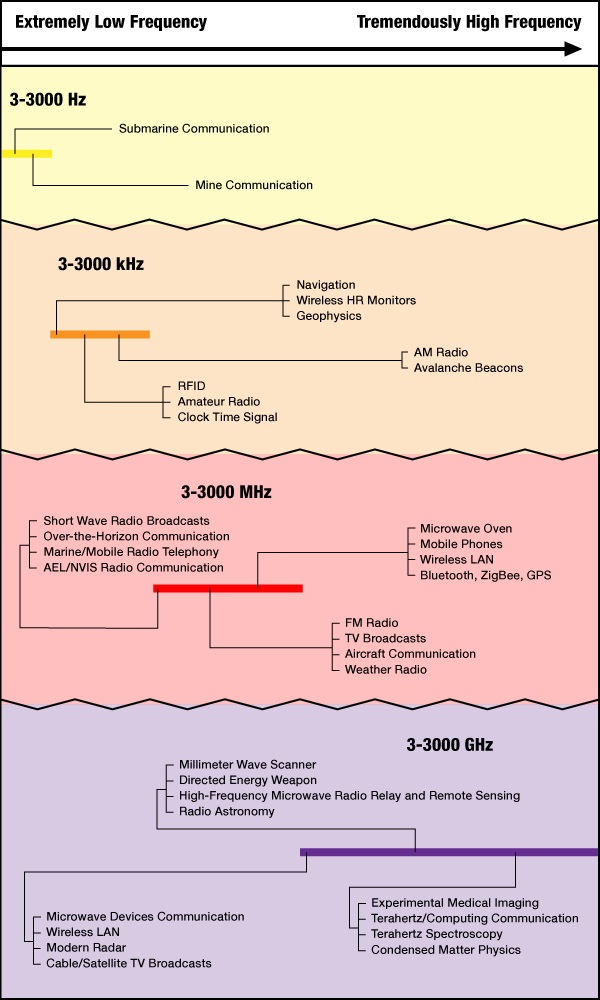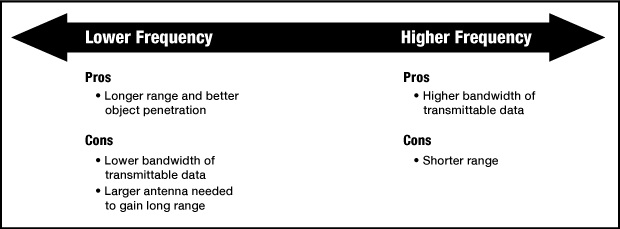At any given moment, there are millions of radio waves swarming around you. If these electromagnetic waves were visible, there would be enough to block you from seeing farther than just a few inches in front of your face. Radio waves control everything from cell phones to wireless networks to garage doors. Even microwave ovens and satellites would not be able to function without these invisible waves that transmit music, pictures and data through the air completely undetected by humans.
The used radio frequency spectrum runs from the Extremely Low Frequency (ELF) of around 30 Hz used for submarine communication to the Tremendously High Frequency (THF) of 3000 GHz used experimentally in physics and medical imaging. Because some frequencies are better at longer range, travelling through obstacles, or transmitting more data, scientists and engineers have settled on using certain frequency bands for certain purposes. For example, ELF is useful for communication in submarines and inside mines and caves because of its ability to travel long ranges while penetrating water and rock. However, its frequency is actually lower than the range of audible sound, making it a weak means for transmitting data. The general rule of thumb is: the lower the frequency, the lower the bandwidth of transmitted data. But, the lower the frequency, the longer the range and the longer the antennae need to be in order to gain that range.

The Federal Communications Commission (FCC) allocates different frequencies for different purposes. In the US, the 0.90, 2.4 and 5.0 GHz frequency bands were set aside in the 80’s by the FCC for unlicensed Industrial, Scientific and Medical (ISM) short-range radio frequency band applications. When assigning these ISM bands just before all our home technology went cordless, it was important that the frequencies weren’t so high that they sacrificed broadcast penetration through walls, but also not so low that they required a huge antenna. These ISM bands are highly attractive to gadget builders because by being unlicensed, they are free. Making them free is also beneficial to the FCC because it encourages new tech products to be designed for frequencies that don’t interfere with other licensed devices, such as 1.9 GHz, which is the frequency of cell phones, and the 535 kHz and 1.7 MHz frequencies, which are AM radio broadcasts.
Ähnliches Produkt:
Did you know that despite having three main unlicensed bands set aside for tech devices, most if not all of your wireless devices run on the same radio frequency? You pretty much live your life on 2.4 GHz and probably didn’t even know it. Ultimately it was decided that 2.4 GHz is the optimum of the three for most home uses. While a 900 MHz wireless home phone may broadcast better through a multi-floor house, a 2.4 GHz system will have a longer unobstructed range and would require a smaller antenna. This allows the actual portable phone size to be smaller, and as everyone knows in electronics, the smaller the better. The 900 MHz, or 0.90 GHz frequency is very narrow, which limits its maximum data rates, though it is able to better penetrate obstructions. The 900 MHz band is commonly used by applications such as SCADA and RFID, which have lower data rate requirements than applications found in the 2.4-5 GHz frequency bands. The type of data packet usually sent in these applications is a simple ON/OFF command such as to a motor or a valve.
Ähnliches Produkt:
What about the unlicensed 5.0 GHz band? With the codification of the Institute of Electrical and Electronics Engineers (IEEE) standard, 802.11a, Wi-Fi routers settled on 5 GHz as their frequency. Then, the IEEE decided 2.4 GHz is a better choice due to its wide channel selection and range/penetration/cost potential. Because 2.4 GHz has become the frequency of choice for home and commercial business use, everything from cordless phones to wireless printers to all your Bluetooth gadgets uses it. With the deluge of home wireless devices, this band has started to experience overcrowding, evident by a weak or nonexistent Wi-Fi network signal. Many wireless N routers can operate on both frequencies, and users have begun switching their routers to use the less crowded 5 GHz frequency when their connected devices have the capability. This frequency is often used in commercial Wi-Fi applications and in the emerging 802.11ac standard, which provides up to 1.2 Gbps of wireless data throughput. At a higher frequency than 2.4 GHz, 5.0 better handles high data rates for voice, video and data communication. But keep in mind the rule of thumb – at a higher frequency, this super-speed band has the shortest range of all three ISM frequency bands.

So why do these consumer wireless devices have to stick to exactly 2.4 GHz? Couldn’t a router function just as well at 2.3 or 2.5 GHZ? We know now that the FCC rules enforce the 2.4 GHz band, which runs from 2,400 to 2,483.5 MHz, but why? Back when ISM bands were being established, the FCC had to take into consideration all existing equipment that uses frequencies around this sweet spot for wireless devices. It was then that they realized a friendly kitchen appliance used in almost every American home since the 1950’s operates at 2.45 GHz. Despite their heavy shielding, microwave ovens still tend to interfere with neighboring frequencies. For this reason, it was decided that a few megahertz of buffer space should be enforced around the microwave oven’s powerful emissions. Hence, the 2.4 GHz ISM band is strictly limited to 2,400 to 2,485 MHz. In general interference has been minimized, but if you are ever experiencing intermittent router interference on the 2.4 GHz band, it’s worth double-checking that you don’t have an aging microwave nearby that needs to be replaced. Interestingly enough, fluorescent lighting can also emit 2.4 GHz, so it’s best to distance your devices from this type of lighting as well.
Some technologies are designed to do their part to prevent frequency interference. Bluetooth, also on 2.4 GHz, has what is called Frequency Hopping Spread Spectrum (FHSS). It rotates between 70 randomly selected frequencies within its range, changing 1,600 times a second. Doing this makes it very unlikely that two devices will land on the same frequency, and even if they do, it won’t last long. Other Bluetooth technology employs what is called Adaptive Frequency Hopping (AFH), which takes interference prevention a step further. It actually identifies “bad” channels (those already in use) and activates a switch to another frequency within the band.
With the ever-increasing quantity of wireless devices around the home, we have quite a few invisible waves zooming past our heads. Though there are three free designated ISM bands, most devices operate on 2.4 GHz, allocated not only to prevent interference with existing technology such as microwaves, but to provide optimal range and object penetration without a massive antenna requirement. As this spectrum becomes more crowded, we can expect more devices to have the option of operating on 5.0 GHz and for newer features to be added on wireless devices to further prevent device interference.




